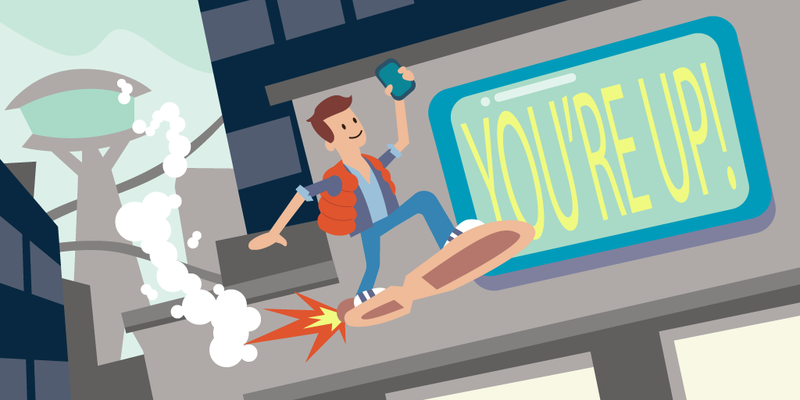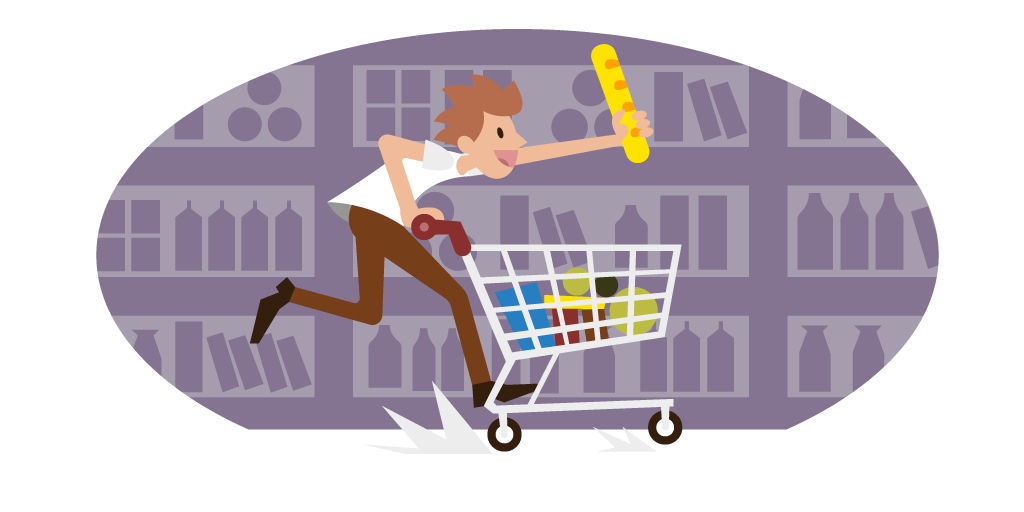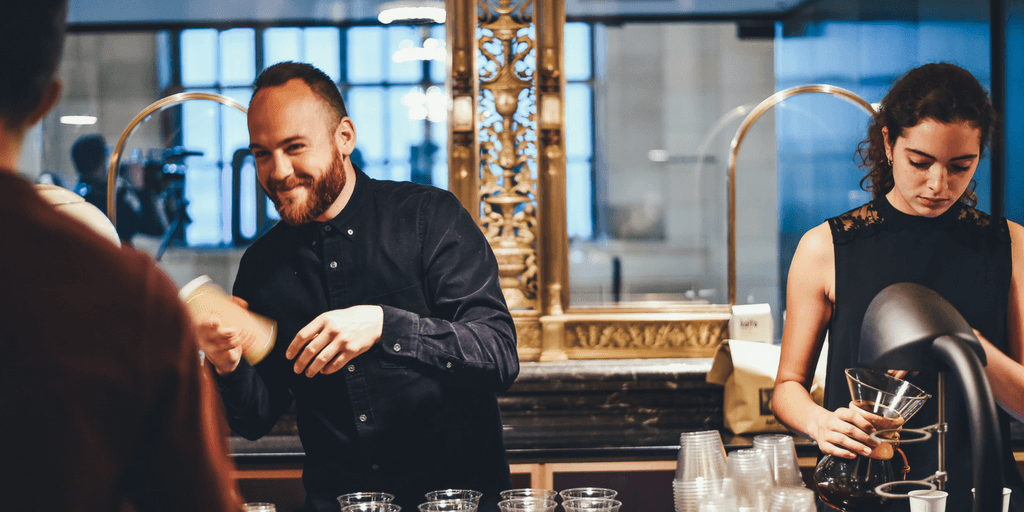Digital queue management systems are, to quote Leonardo DiCaprio's famous line from the Aviator, "the way of the future".
Queue management systems (QMS) mesh a variety of technologies, all working in harmony together. We don’t often think of the parts, just like we don’t question how hardware, software and colorful cables work together in our computers — we only see the end result.
By knowing how each part in queue technologies work, we have the power to improve queue management and ultimately, deliver the best possible customer service. In this article, we are going to explore the positive effects of technology on queue management.
If you want to skip the theory and leap straight into action, get a free 14-day trial of Qminder right now!
Self-Service Sign-In

The most recognizable part of a digital queue management system is the electronic sign-in device. That’s the digital screen — such as an iPad — located near the front of a store.
Customers walk into a business and tap the screen to sign in, adding their name to the automated queueing system. No need for customers to impatiently tap their feet while standing in line, waiting for the unknown.
They’re free to spend their time as they please.
Whether that be sitting in the waiting room of a doctor’s office, or wandering the aisles of an archery store until customers are called to be served.
That’s all well and good. But how exactly does electronic sign-in as part of a digital queue management system improve queues?
Shortened Waiting Times
Let’s get real for a second: Waiting in line is not a pleasant experience.
About 20% of customers report feeling irritated just by queuing. The pins and needles caused in a customer’s heels boil into frustration, irritation, and sometimes eruption: when customers leave the store.
Electronic sign-in minimizes the standing-in-line experience, or in many cases does away with it altogether. Customers can’t feel frustrated from waiting in line if they’re not waiting in line. That’s logic anyone can follow.
See, the issue is traditional queuing practices just aren’t efficient. MIT’s Dr. Richard Larson pointed out the inefficiencies back in 1987.
Just look at your local grocery store: customers jump in and out of lines trying to get out faster while cradling milk and eggs. It’s a poor, inefficient system, one that queueing theory opposes for its poor customer service.
If we’re going to improve queues we need queue management technology. With electronic sign-in, customers are free to wander the store instead of feeling shackled to the line. That freedom creates the perfect opportunity for an impulse purchase, while also showing consideration for the customer's time.
When we wait in ignorance, we feel weak — powerless, like prisoners of fate. Humanity hates uncertainty.
But electronic sign-in minimizes those sensations and improves queues by reducing real wait time and the perceived wait time.
Fairness in Service
Everyone feels that sense of unfairness when it comes to waiting in lines. Why does the other person get called up when you arrived before them?
Often times, the reasons are unknown to the customer. Without knowing the context, all they know is that they’ve been cheated.
Not only is queue management improved but each customer receives the individual attention they deserve.
Personalized Experience
Since customers use their names to sign-in, the automated queueing system creates a personalized customer experience.
Particular areas of the brain are activated when we hear our names called — because nothing is more intimate to us than our names.
Think back to the butterflies in your stomach you felt when your school crush first said your name — or to the shivers down your spine when mom found out her favorite vase was broken and yelled out your name.
(Sorry if this one hit too close to home.)
Remember, customers are willing to spend 9% more with businesses that provide extraordinary customer service. When employees call customer’s names they’re establishing a warm, friendly atmosphere.
Improved queues and personal attention mesh together to foster an environment customers want to shop in. And it’s thanks to a modern queue management system.
Service Intelligence Analytics

These days, data drives everything. Data gives us insights into the all too human aspects of life, including business.
Queue management technology is all about data — data that, when harnessed properly, vastly improves queue management.
What can we learn from queue analytics?
Wait Times
Information collected from a queue management system informs businesses as to how long customers are waiting. Which can reveal both efficiencies and inefficiencies.
Maybe the average waiting time for customers has increased month-to-month. That brings up questions: What’s happening? What can we do to improve? What did we change?
In the same vein, maybe the average waiting time has decreased. In that case, what have we done right? What are we doing that’s working?
Our capacity as humans to manage large data sets is limited. But with queue management technology, we can track data over long periods of time, prompting the aforementioned questions.
Data collected from queue technologies is all about improving the business.
Comparing Locations
Data can also be used to analyze different branches. It’s fine to notice that the Starbucks in Fair Park isn’t performing well, compared to its sister location in Baton Rouge. But noticing isn’t always enough.
Queue management technology like Qminder’s Service Intelligence informs businesses exactly how well a store is performing.
Combining QMS data with footfall analytics rewards constructive information. It’s data that managers and store owners can use to strategize, seeing what works and what doesn’t.
Performance Tracking
There’s one more benefit of data: performance tracking.
Information collected through queue management technology provides data on which employees are achieving and which need some additional help.
Remember, employees are often a business’ frontline: they epitomize the culture of a store and can make or break a sale. In other words, they are the personification of your store’s customer service.
Use data to reward employees who perform well. Incentivize their continued excellence. And then help those employees who are underperforming.
Let’s keep things real: you might be doing great with gathering data, but this might be just a huge waste. Remember, data collection is useless unless the data is being analyzed and used to improve on existing services.
Timely Notifications

Here’s where collected data becomes immediately practical: notifications.
Let’s imagine that every Thursday, around 6:00 PM, a store’s traffic increases. That’s a very valuable piece of information.
Why?
Managers know to assign more employees to work that shift. In addition, the queueing system will send out a notification to employees to alert them about the increased traffic—in real-time.
Now, not only are managers empowered with information but so are the employees on the floor.
The data-backed notification prepares employees for the incoming population increase, providing a mental fortification and immediately alerting employees to prioritize the coming wave.
But wait, there’s more.
Every time a customer uses the electronic sign-in, a notification is sent to employees alerting them of a new customer. So if you find yourself at a dentist’s office, no time is wasted telling the receptionist you have arrived. The receptionist can occupy their time servicing you.
Notifications don’t end there.
If an employee is idle, and a visitor is waiting, they’ll receive an immediate alert informing them about the customer. Notifications place customers first and prioritize their place in the queue, pushing them through the business for an efficient, pleasant experience.
QMS like Qminder also sends weekly statistics to inform a business as to how they are performing. Perhaps previous data says this past week’s wait time was abnormal? Time to make improvements, then.
Real-time notifications avoid the fuss managers have to go through to meet the dynamic demand of queues.
SMS and Text Messaging
During the smartphone revolution, every company found itself wanting a smartphone app — something users have to download and install. But today, people are inundated by apps and limited by scant internal storage.
In short: Apps are out. SMS is in.
“SMS” is a short message service — what you may know as a text message. And it plays a big role in providing convenience for customers. Queue management technology sends out a friendly text to customers, telling them when it's their turn to be served.
There’s no anxiety for customers worried their name won't be called. And they’re free to wander the store or browse around on their smartphone while they wait to be served.
Cloud and Software as a Service

“Cloud technology” has been a buzzword for the last decade, without anyone really knowing what it means. Is it related to weather forecast? Is it a shamanistic technology to summon rain over your crops?
What cloud really means is that all data — customer information, analytics, employee performance records, etc. — and the software itself is stored on the provider’s servers. Every piece of information is securely backed up on a safe and sound server.
No need to worry about bad luck (a fire or ill-willed lightning strike) wiping hard drives or mismanaged resources.
This means no meddling with hardware or software compatibility. No replacement parts like paper and ink. No wires. No hassle.
It’s no wonder that businesses using a cloud-based QMS aren’t likely go back to traditional hardware-based technology. Cloud-based QMS is cheaper, convenient and trouble-free.
Qminder is a cloud-based queue management system that provides everything covered in this article. By paying monthly subscription, you get access to the experience-boosting technology and kick your business strategy into overdrive.
Qminder is free to use for 14 days. The best thing about this proposition is that you’ll be given full access as if you were paying for the service at full-price. You don’t even need to take your credit card out of your wallet — feel free to use Qminder however you like for these two weeks.
Learning about the technologies at work in a queue management system not only gives a deeper appreciation of QMS, but also helps businesses better improve their queues.
Because improving queues enhances the customer’s experience and the employees. And when everyone’s life is made easier, businesses can focus on what truly matters — their customer service.






